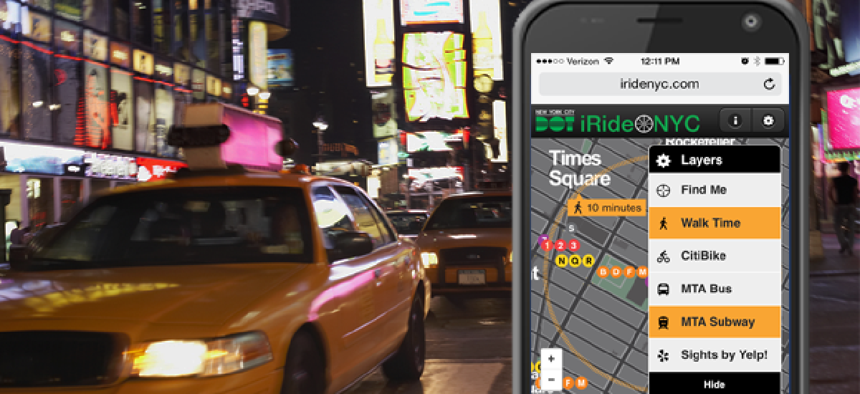Bootstrapped web app delivers NYC transit options


Connecting state and local government leaders
Using open source technology, in-house development expertise and a scalable cloud architecture, the New York City Transportation Department created iRideNYC, a much-needed mobile transit solution at a fraction of the estimated cost.
With an annual subway ridership of 1.7 billion in 2013 and the 11th largest bus fleet in North America, New York City’s transportation system is one of the world’s largest. Even in this public transit-friendly city though, 10 percent of the city’s residents and visitors are lost at any given time, according to the city’s Transportation Department.
Project at a glance
Project: iRideNYC
Office: New York City Department of Transportation, IT & Telecom
Technology used: Responsive HTML 5 code base; Esri and Mapbox products in addition to the Entity Framework 5.0 object-relational mapper and an open source stack; Python 2.7 to process transit data in real-time and SQLITE, an open source relational database management system; Amazon Web Services Elastic Compute Cloud (EC2) for hosting.
Time To Implementation: 6 months
Before: Residents of and visitors to New York City had to navigate one of the world’s largest transit systems by walking into a subway station to get arrival times or using information sources that lacked additional transit options.
After: IRideNYC, a location-based web app, finds users in seconds and automatically provides transit options in addition to information on nearby sights and events.
To help them find their way, NYCDOT developed the first web app with actual, not scheduled, transit information. That means users can use iRideNYC, built on HTLM 5, to see real timetables using data streams from New York state’s Metropolitan Transportation Authority (MTA), New York City’s CitiBike vendor, user geographical data and “online urban guide” Yelp.com.
“It recreates the experience of a local app, but you always have up-to-the minute information,” said Cordell Schachter, chief technology officer at NYCDOT.
Within seconds, iRideNYC finds users on the map and offers transit options. Before, New Yorkers had to go into subway stations to check times or use information sources that lacked additional transit options.
iRideNYC consolidates data on the Big Apple’s 6,000 of miles of road, 12,750 miles of sidewalks, 6,000-bike sharing program and robust car-for-hire to make it useful. It can take into account roads affected by construction or maintenance, for example, and lead users to more efficient routes.
Additionally, iRideNYC can suggest nearby sights, CitiBike station locations and real-time bike availability as well as upcoming events within walking distance by time. The latter was part of the development team’s goal to promote neighborhood exploration through the app.
The team built the app in 450 hours over six months at a cost of $50,000, well under the contractor estimate of $2 million. It worked with the same mobile development platform NYCDOT used to document damage from Hurricane Sandy in 2012. For interactive maps, it uses Esri and Mapbox products in addition to the Entity Framework 5.0 object-relational mapper and an open source stack that includes QGIS geographic information system code and Mapbox’s TileMill.
To process data in real time, the department uses Python 2.7 programming language and SQLITE, an open source relational database management system.
P’arry Drew, GIS developer at NYCDOT, said the MTA provides a series of files that get updated whenever the it provides a live feed, which is about every 30 seconds. The data stream must include GIS information so it can be plotted on a map. “We’re able to take that using a Python script and fold it into our database here, and then we’re able to make that into a web service,” he said.
The whole system is hosted on Amazon Web Services Elastic Compute Cloud, Elastic Load Balancing, Auto Scaling and CloudWatch.
One challenge Schachter and his team encountered was fitting everything on a smart phone screen. Their solution was a mobile first strategy that also incorporated responsive web design, which means that phones, tablets and desktop computers access the same HTML 5 code base that formats a map optimized to the size of the screen in use. iRideNYC works on most Internet browsers: Chrome, Safari, Firefox and Internet Explorer.
“Mobile devices are really the true personal computer in that we have them on our person, we take them with us,” Schachter said. “It was very important that it work for mobility. Really, we had the vision before we had the technology.”
Chandrima Pal, a senior GIS developer at Esri who consulted on iRideNYC, attributes part of the app’s accomplishments to collaboration among people who hadn’t worked together before.
Faced with a procurement process that required the project to be completely scoped out (to ensure transparent and fair bidding), the team used free, open source technology, as well as in-house development expertise and a scalable cloud architecture.
Additionally, NYCDOT delivered a highly repeatable mobile development platform and technology stack that can, and has already been, leveraged to develop numerous other innovative solutions.
A new iteration of the app is due out this fall. It will offer improved menus so that users can get all the information they need with two clicks. The first click will be for mode of transportation – bus or train – and then another to see the schedule.




